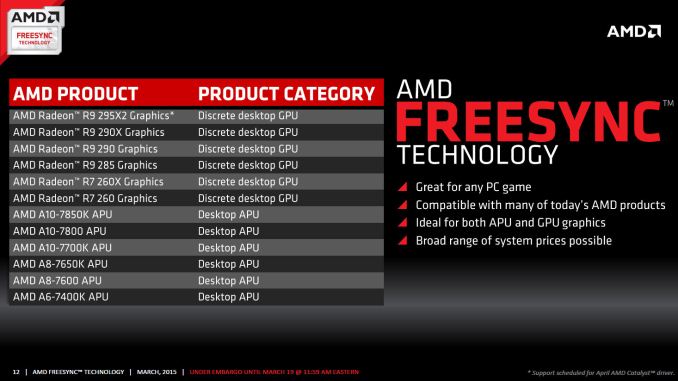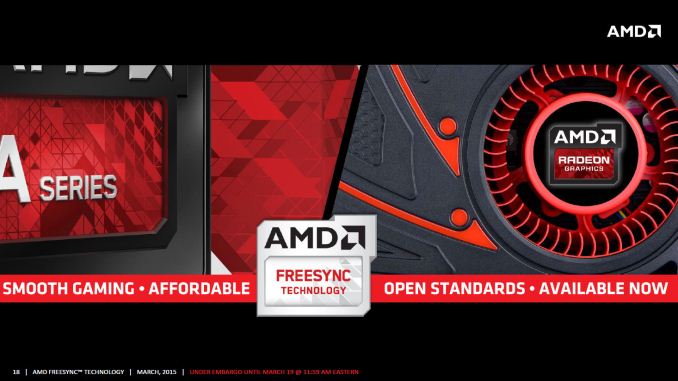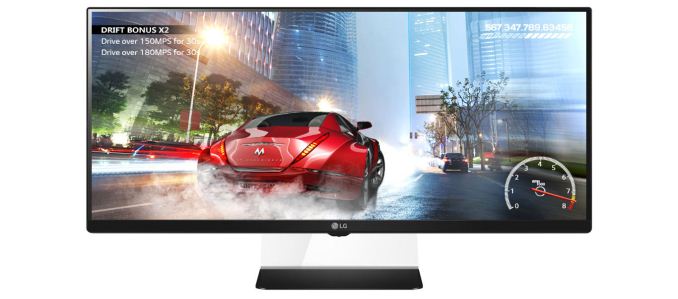The AMD FreeSync Review
by Jarred Walton on March 19, 2015 12:00 PM ESTClosing Thoughts
It took a while to get here, but if the proof is in the eating of the pudding, FreeSync tastes just as good as G-SYNC when it comes to adaptive refresh rates. Within the supported refresh rate range, I found nothing to complain about. Perhaps more importantly, while you’re not getting a “free” monitor upgrade, the current prices of the FreeSync displays are very close to what you’d pay for an equivalent display that doesn’t have adaptive sync. That’s great news, and with the major scaler manufacturers on board with adaptive sync the price disparity should only shrink over time.
The short summary is that FreeSync works just as you’d expect, and at least in our limited testing so far there have been no problems. Which isn’t to say that FreeSync will work with every possible AMD setup right now. As noted last month, the initial FreeSync driver that AMD provided (Catalyst 15.3 Beta 1) only allows FreeSync to work with single GPU configurations. Another driver should be coming next month that will support FreeSync with CrossFire setups.
Besides needing a driver and FreeSync display, you also need a GPU that uses AMD’s GCN 1.1 or later architecture. The list at present consists of the R7 260/260X, R9 285, R9 290/290X/295X2 discrete GPUs, as well as the Kaveri APUs – A6-7400K, A8-7600/7650K, and A10-7700K/7800/7850K. First generation GCN 1.0 cards (HD 7950/7970 or R9 280/280X and similar) are not supported.
All is not sunshine and roses, however. Part of the problem with reviewing something like FreeSync is that we're inherently tied to the hardware we receive, in this case the LG 34UM67 display. Armed with an R9 290X and running at the native resolution, the vast majority of games will run at 48FPS or above even at maximum detail settings, though of course there are exceptions. This means they look and feel smooth. But what happens with more demanding games or with lower performance GPUs? If you're running without VSYNC, you'd get tearing below 48FPS, while with VSYNC you'd get stuttering.
Neither is ideal, but how much this impacts your experience will depend on the game and individual. G-SYNC handles dropping below the minimum FPS more gracefully than FreeSync, though if you're routinely falling below the minimum FreeSync refresh rate we'd argue that you should lower the settings. Mostly what you get with FreeSync/G-SYNC is the ability to have smooth gaming at 40-60 FPS and not just 60+ FPS.
Other sites are reporting ghosting on FreeSync displays, but that's not inherent to the technology. Rather, it's a display specific problem (just as the amount of ghosting on normal LCDs is display specific). Using higher quality panels and hardware designed to reduce/eliminate ghosting is the solution. The FreeSync displays so far appear to not have the same level of anti-ghosting as the currently available G-SYNC panels, which is unfortunate if true. (Note that we've only looked at the LG 34UM67, so we can't report on all the FreeSync displays.) Again, ghosting shouldn't be a FreeSync issue so much as a panel/scaler/firmware problem, so we'll hold off on further commentary until we get to the monitor reviews.
One final topic to address is something that has become more noticeable to me over the past few months. While G-SYNC/FreeSync can make a big difference when frame rates are in the 40~75 FPS range, as you go beyond that point the benefits are a lot less clear. Take the 144Hz ASUS ROG Swift as an example. Even with G-SYNC disabled, the 144Hz refresh rate makes tearing rather difficult to spot, at least in my experience. Considering pixel response times for LCDs are not instantaneous and combine that with the way our human eyes and brain process the world and for all the hype I still think having high refresh rates with VSYNC disabled gets you 98% of the way to the goal of smooth gaming with no noticeable visual artifacts (at least for those of us without superhuman eyesight).
Overall, I’m impressed with what AMD has delivered so far with FreeSync. AMD gamers in particular will want to keep an eye on the new and upcoming FreeSync displays. They may not be the “must have” upgrade right now, but if you’re in the market and the price premium is less than $50, why not get FreeSync? On the other hand, for NVIDIA users things just got more complicated. Assuming you haven’t already jumped on the G-SYNC train, there’s now this question of whether or not NVIDIA will support non-G-SYNC displays that implement DisplayPort’s Adaptive Sync technology. I have little doubt that NVIDIA can support FreeSync panels, but whether they will support them is far less certain. Given the current price premium on G-SYNC displays, it’s probably a good time to sit back and wait a few months to see how things develop.
There is one G-SYNC display that I’m still waiting to see, however: Acer’s 27” 1440p144 IPS (AHVA) XB270HU. It was teased at CES and it could very well be the holy grail of displays. It’s scheduled to launch next month, and official pricing is $799 (with some pre-orders now online at higher prices). We might see a FreeSync variant of the XB270HU as well in the coming months, if not from Acer than likely from some other manufacturer. For those that work with images and movies as well as playing games, IPS/AHVA displays with G-SYNC or FreeSync support are definitely needed.
Wrapping up, if you haven’t upgraded your display in a while, now is a good time to take stock of the various options. IPS and other wide viewing angle displays have come down quite a bit in pricing, and there are overclockable 27” and 30” IPS displays that don’t cost much at all. Unfortunately, if you want a guaranteed high refresh rate, there’s a good chance you’re going to have to settle for TN. The new UltraWide LG displays with 75Hz IPS panels at least deliver a moderate improvement though, and they now come with FreeSync as an added bonus.
Considering a good display can last 5+ years, making a larger investment isn’t a bad idea, but by the same token rushing into a new display isn’t advisable either as you don't want to end up stuck with a "lemon" or a dead technology. Take some time, read the reviews, and then find the display that you will be happy to use for the next half decade. At least by then we should have a better idea of which display technologies will stick around.













350 Comments
View All Comments
JarredWalton - Thursday, March 19, 2015 - link
Try counting again: LG 29", LG 34", BenQ 27", Acer 27" -- that's four. Thanks for playing. And the Samsung displays are announced and coming out later this month or early next. For NVIDIA, there are six displays available, and one coming next month (though I guess it's available overseas). I'm not aware of additional G-SYNC displays that have been announced, so there's our six/seven. I guess maybe we can count the early moddable LCDs from ASUS (and BenQ?) and call it 8/9 if you really want to stretch things.I'm not saying G-SYNC is bad, but the proprietary nature and price are definitely not benefits for the consumer. FreeSync may not be technically superior in every way (or at least, the individual implementations in each LCD may not be as good), but open and less expensive frequently wins out over closed and more expensive.
chizow - Friday, March 20, 2015 - link
@Jarred, thanks for playing, but you're still wrong. There's 8 G-Sync panels on the market, and even adding the 1 for AMD that's still double, so how that is "nearly caught up" is certainly an interesting lens.Nvidia also has panels in the works, including 2 new, major breakthroughs like the Acer 1440p IPS, 1st 144Hz, 1440p, IPS VRR panel and the Asus ROG Swift 4K IPS, 1st 4K IPS VRR monitor. So yes, while AMD is busy "almost catching up" with low end panels, Nvidia and their partners are continuing to pioneer the tech.
As for FreeSync bringing up the low end, I personally think it would be great if Nvidia adopted AdaptiveSync for their low end solutions and continued to support G-Sync as their premium solution. It would be great for the overwhelming majority of the market that owns Nvidia already, and would be one less reason for anyone to buy a Radeon card.
TheJian - Sunday, March 22, 2015 - link
You sure have a lot of excuses. This is beta 1.0, it's the lcd's fault (pcper didn't think so), assumption that open/free (this isn't free, $50 by your own account for freesync, which is the same as $40-60 for the gsync module right?, you even admit they're hiking prices at the vendor side for $100+) is frequently the winner. Ummm, tell that to CUDA and NV's generally more expensive cards. There is a reason they have pricing power (the are better), and own 70% discrete and ~75% workstation market. I digress...anubis44 - Tuesday, March 24, 2015 - link
@chizow:"I'll bet on the market leader that holds a commanding share of the dGPU market, consistently provides the best graphics cards, great support and features, and isn't riddled with billions in debt with a gloomy financial outlook."
You mean you'll bet on the crooked, corrupt, anti-competitive, money-grubbing company that doesn't compensate their customers when they rip them off (bumpgate), and has no qualms about selling them a bill of goods (GTX970 has 4GB ram! Well, 3.5GB of 'normal' speed ram, and .5GB of much slower, shitty ram.), likes to pay off game-makers to throw in trivial nVidia proprietary special effects (Batman franchise and PhysX, I'm looking right at you)? That company? Ok, you keep supporting the rip-off GPU maker, and see how this all ends for you.
chizow - Tuesday, March 24, 2015 - link
@Anubis44: Yeah again, I don't bother with any of that noise. The GTX 970 I bought for my wife in Dec had no adverse impact from the paper spec change made a few months ago, it is still the same fantastic value and perf it was the day it launched.But yes I am sure ignoramuses like yourself are quick to dismiss all the deceptive and downright deceitful things AMD has said in the past about FreeSync, now that we know its not really Free, can't be implemented with a firmware flash, does in fact require additional hardware, and doesn't even work with many of AMD's own GPUs. And how about CrossFireX? How long did AMD steal money from end-users like yourself on a solution that was flawed and broken for years on end, even denying there was a problem until Nvidia and the press exposed it with that entire runtframe FCAT fiasco?
And bumpgate? LMAO. AMD fanboys need to be careful who they point the finger at, especially in the case of AMD there's usually 4 more fingers pointed back at them. How about that Llano demand overstatement lawsuit still ongoing that specifically names most of AMD's exec board, including Read? How about that Apple extended warranty and class action lawsuit regarding the same package/bump issues on AMD's MacBook GPUs?
LOL its funny because idiots like you think "money-grubbing" is some pejorative and greedy companies are inherently evil, but then you look at AMD's financial woes and you understand they can only attract the kind of cheap, ignorant and obtusely stubborn customers LIKE YOU who won't even spend top dollar on their comparably low-end offerings. Then you wonder why AMD is always in a loss position, bleeding money from every orifice, saddled in debt. Because you're waiting for that R9 290 to have a MIR and drop from $208.42 to $199.97 before you crack that dusty wallet open and fork out your hard-earned money.
And when there is actually a problem with AMD product, you would rather make excuses for them and sweep those problems under the rug, rather than demand better product!
So yes, in the end, you and AMD deserve one another, for as long as it lasts anyways.
Yojimbo - Thursday, March 19, 2015 - link
HD-DVD was technically superior and higher cost? It seems BlueRay/HD-DVD is a counterexample to what you are saying, but you include it in the list to your favor. Laserdisc couldn't record whereas VCRs could. Minidisc was smaller and offered recording, but CD-R came soon after and then all it had was the smaller size. Finally MP3 players came along and did away with it.There's another difference in this instance, though, which doesn't apply to any of those situations that I am aware of, other than minidisc ): G-Sync/FreeSync are linked to an already installed user base of requisite products. (Minidisc was going up against CD libraries, although people could copy those. In any case, minidisc wasn't successful and was going AGAINST an installed user base.) NVIDIA has a dominant position in the installed GPU base, which is probably exactly the reason that NVIDIA chose to close off G-Sync and the "free" ended up being in FreeSync.
Assuming variable refresh catches on, if after some time G-Sync monitors are still significantly more expensive than FreeSync ones, it could become a problem for NVIDIA and they may have to either work to reduce the price or support FreeSync.
chizow - Thursday, March 19, 2015 - link
Uh, HD-DVD was the open standard there guy, and it lost to the proprietary one: Blu-Ray. But there's plenty of other instances of proprietary winning out and dominating, let's not forget Windows vs. Linux, DX vs. OpenGL, CUDA vs. OpenCL, list goes on and on.Fact remains, people will pay more for the better product, and better means better results, better support. I think Nvidia has shown time and again, that's where it beats AMD, and their customers are willing to pay more for it.
See: Broken Day 15 CF FreeSync drivers as exhibit A.
at80eighty - Thursday, March 19, 2015 - link
Keep paddling away, son. The ship isn't sinking at allchizow - Thursday, March 19, 2015 - link
If you buy a FreeSync monitor you will get 2-3 paddles for every 1 on a G-Sync panel. That will certainly help you pedal faster.http://www.pcper.com/image/view/54234?return=node%...
at80eighty - Friday, March 20, 2015 - link
oh hey great example - no ghosting there at all. brilliant!